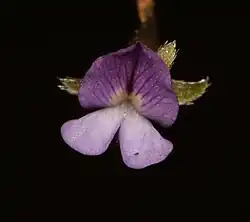Psoralea cataracta
| Psoralea cataracta | |
|---|---|

| |
| Scientific classification | |
| Kingdom: | Plantae |
| Clade: | Tracheophytes |
| Clade: | Angiosperms |
| Clade: | Eudicots |
| Clade: | Rosids |
| Order: | Fabales |
| Family: | Fabaceae |
| Subfamily: | Faboideae |
| Genus: | Psoralea |
| Species: | P. cataracta
|
| Binomial name | |
| Psoralea cataracta C.H.Stirt.
| |
| Synonyms[2] | |
| |
Psoralea cataracta is a species of flowering plant in the family Fabaceae. It was declared extinct in 2008 in the Red List of South African Plants, with a single specimen collected from the Tulbagh Waterfall in 1804. It was rediscovered 200 years later by Brian Du Preez in November of 2019 in the Winterhoek Mountains near Tulbagh.[3] It is endemic to the Western Cape.[4] It is also known by the name waterfall fountainbush.
Description
Psoralea cataracta has small purple flowers dangling on long, thread-like flower stalks.[4]
Distribution
Psoralea cataracta is found around the southern slopes of the Winterhoek Mountains in the Tulbagh Valley.[1]
Conservation status
As of the 2022 classification, Psoralea cataracta is classified as Critically Endangered due to its restricted extent of occurrence and area of occupancy of less than 8 km2, the threat of alien invasive species such as Acacia mearnsii and species of Pinus, and the expansion of farmland in the Winterhoek Mountains.[1]
References
- ^ a b c "SANBI Red List of South African Plants". South African National Biodiversity Institute Threatened Species Programme. Retrieved 2022-04-15.
- ^ "Psoralea cataracta". Plants of the World Online. Royal Botanic Gardens, Kew. Retrieved 15 April 2022.
- ^ Preez, Brian du (2019-11-18). "Waterfall Fountainbush (Psoralea cataracta)". iNaturalist. Retrieved 2022-04-16.
- ^ a b "The rediscovery of the extinct Psoralea cataracta after 200 years". SANBI. 2020-01-09. Retrieved 2022-04-15.
External links
 Data related to Psoralea cataracta at Wikispecies
Data related to Psoralea cataracta at Wikispecies




